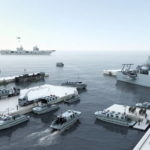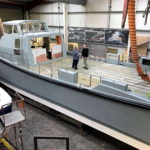Recent UK Ministry of Defence (MOD) contracts for up to 150 next generation boats have given the workboat market further momentum, reports Samantha Fisk
A major development for the workboat market has been the £ 48 bn contract for next-generation workboats for the UK’s[ds_preview] MOD. CSS Boats (part of the MOD) announced that it was looking to purchase up to 150 new boats to support both British ships and British jobs.
The boats themselves will have a flexible, modular design allowing them to adapt to different work environments. »This was a challenging process in which the team had to satisfy many different user groups with just one class of workboat. That is why we came up with a concept where different modules could be fitted to the platforms dependent on task,« explains Garrie Trowbridge, acquisitions lead, DE&S.
The boats will be highly adaptable to operation demand and will be used for passenger transfer, officer and diver training, Antarctic exploration, hydrographic survey and explosive ordinance disposal. The boats will also be fitted with twin waterjet propulsion, along with common steering systems and control systems and will have glass reinforced plastic hulls.
Further developments in the propulsion category has seen Duodrive return with a further update to its propulsions system. Duodrive secured its first patent back in 2002 for a contra-rotating propulsion system for shaft driven craft. Today’s upgraded version enables vessels with a traditional shaft drive arrangement to run contra-rotating propellers, and thereby access the associated reduced running costs and performance advantages of this concept.
The latest Duodrivetrain, which incorporates contra-rotating, enclosed oil lubricated line-shafts and patented gear technology, enables the propulsion thrust to be transferred directly to the hull, eliminating the need for the engine and gearbox to carry this load. This reduces noise, vibration levels and associated maintenance issues, whilst Duodrive suggest the potential for a 30% decrease in fuel usage from the use of contra-rotating propellers alone.
»The main challenge arising from most drive trains today is that you have a driver, a point in the hull that the shaft goes through and an external fixed point that supports the propeller to align all the components usually from different manufacturers. To achieve alignment is very hard when done this way,« says John Carter, managing director, Duodrive. »The alignment tolerances of the different parts are usually well outside the standard levels that you would see in other industries which introduces wear & friction. We took all those tolerances and put them in one package. Then we took the drive train and put it in that envelope as well.«
Contra-rotating propellers
The pair of contra-rotating propellers is the key element within the system, delivering significant fuel savings for the owner and allowing a pay-back period of around two years. »There is a distinct benefit from using a contra-rotating propeller system, although the precise impact depends on the vessel type and its usage. Most vessels are optimised to one optimum design point which has a narrow maximum peak efficiency. By using a contra-rotating propeller system, you see a much flatter performance curve, with elevated efficiency over a wider range,« says Carter.
There are other less well-known benefits of contra-rotating propellers, Carter continued; for example, any vessel having a single drive will not suffer torque reaction or »prop walk«. As the total thrust is effectively divided between two propellers, selection for lower cavitation is possible which can result in improved bollard pull for tugs or higher speeds rather than defaulting to inefficient jet drives.
Tests are due to be carried out during August & September on their own demonstrator vessel to show what the »hard numbers« will be, Mr Carter states. The practical testing will allow Duodrive to rule out any potential variables and show what the efficiency step change really is when the latest generation Duodrivetrain is retro-fitted to a shaft drive vessel.
Samantha Fisk




















